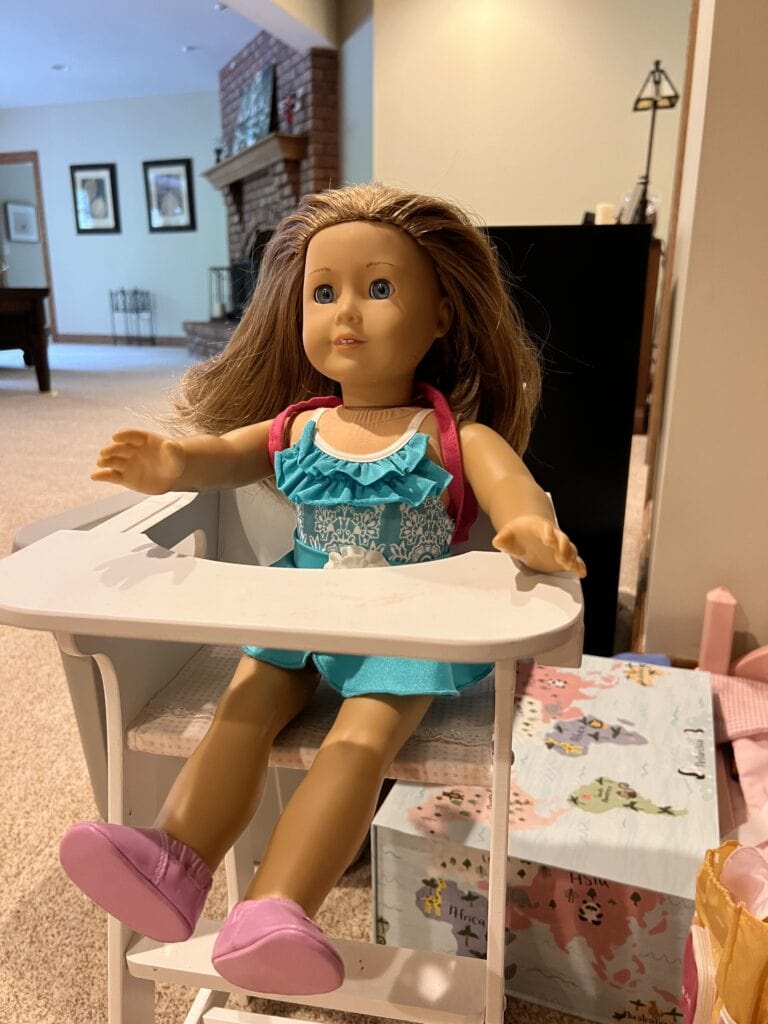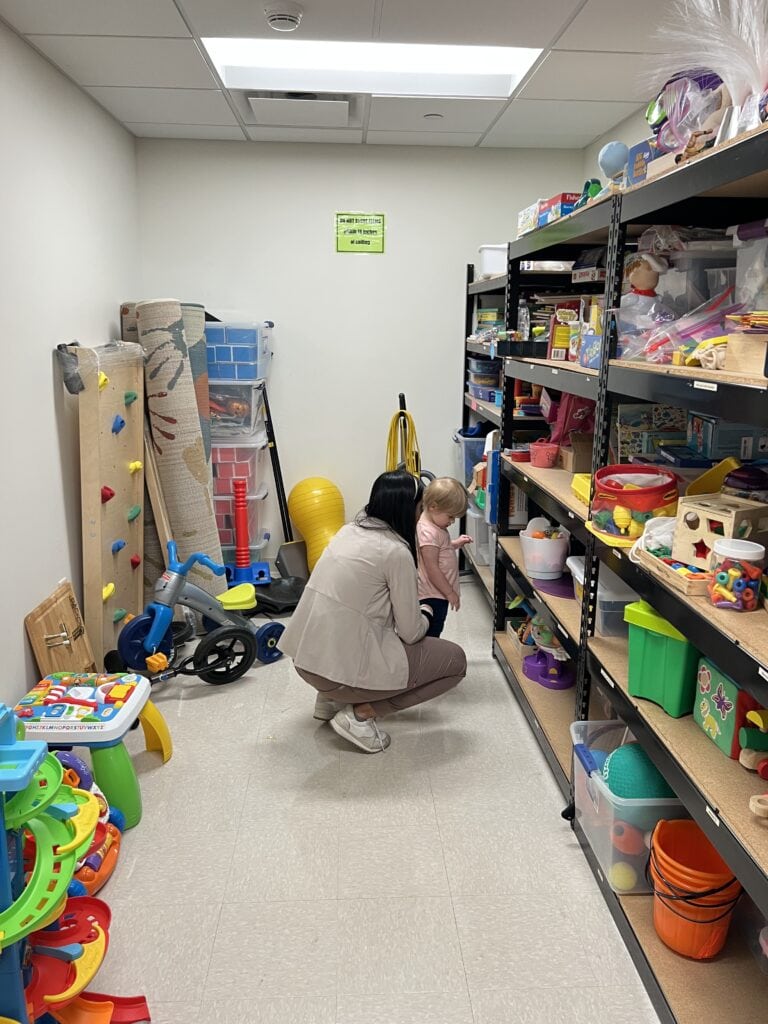Play to Learn: Child Play Therapy with Food Canisters
Imagine walking into your kitchen while your kiddo is eating. You find food in their hair, on their face, on the wall, the chair, the floor, and – well, you get the picture… There is food everywhere!
As pediatric developmental therapy specialists, we have you covered! We came up with several fun ways for your child to play with their food without making a mess! Impossible you say? Well folks, it’s time to introduce you to: food canisters!

Easy Ideas for Child Play Therapy at Home
This week we will talk about a variety of simple play ideas you can do with a canister you may already have in your home. We love this idea because you don’t have to purchase anything special. Learn how to upcycle food containers into a fun, engaging toys for child play therapy!
Food containers, like oatmeal canisters,* come in all shapes, sizes, and textures. Even though a food canister doesn’t seem like a toy, with a little paper, glue, and a smidge of creativity you too can make it fun. All general rules apply to playing with toys, and that means letting your child lead.
You can also use it as an opportunity to model some great language, so we’ll make general suggestions like we have in our other blogs (listed in parentheses) as you read along.
Creative Food Canister Ideas to Promote Simple Play
Start by cutting a hole in the lid and dropping items in. You can use any toy that can fit through the hole, or, if you’re brave enough, you can use their food pieces! (You dropped it. It’s in.) You can also open the canister and dump items out. (Lid. It’s off. They came out.)
Another idea is pushing small cotton balls through the opening. (Push it. It’s in.) This helps promote simple play as well as creates a calming activity for your child to engage in if they become overwhelmed or frustrated.
DIY Ideas for Sensory Play Therapy for Kids
Cut slits in the top of an empty food canister, and slide popsicle sticks, pipe cleaners, or ribbon in and out of the container. (Stick. You pushed it in. We’re pulling the string.) This is a great way to introduce new sensory items to your kiddo, including textured ribbons or tissues.
Another sensory play therapy component is encouraging your little one to shake items in the canister. (We’re shaking it. It’s loud/quiet.) You can also roll the canister back and forth with the items in. (Look! It’s rolling!)
Place the canister on a table or the ground and turn it into a drum! (We’re playing the drum. It’s loud!) You can encourage your toddler to sit, stand, lay on their stomach, and/or kneel while drumming to engage their core and play in a variety of positions! These positions can help strengthen your kiddo’s core, legs, and arms.

Re-use Food Canisters to Encourage Combination Play
You can collect several canisters and pour items from one canister to the next. (We’re pouring the rice. It’s full. You dumped the animals out. Now, it’s empty.) You can also use these canisters to introduce sorting colors, objects, or shapes. (Fill it with green. This one has squares.)
Take this play therapy concept to the next level and encourage your kiddo to pour the items themselves, using one or both hands. This can also engage the core and promote bilateral coordination.

Use cardboard to make a ramp from the top of the canister and have toy cars roll up the ramp and into the canister. (Ramp. It went up the ramp. The car is in. It’s in the garage.) You can also use the ramp to push the cars down. Alternatively, use small cotton balls or toy animals to go up and down the cardboard ramp.
How to Upcycle Food Canisters to Facilitate Imaginary Play Therapy for Kids
Create a silo with the canister by decorating it with paper, and have toy animals go in and out of the silo. (Cow. The cow is on top. He fell down.) You can use your other food canisters to make a farm and encourage your toddler to play with the different structures and walk the animals back and forth. (The cow is in the barn, now he is in the silo.)

Use the canister to create an animal, such as a caterpillar, and cut a hole in the lid as a mouth. Feed the animal toy food. (The caterpillar is hungry. You’re feeding him a sandwich. He’s eating. The sandwich is yummy.)
How do toys help child development?
This imaginative play activity is a great opportunity to work in different textures for your child to explore, using smooth textures like soft plastic as the nose, and fuzzy fabric like fleece or felt for the body. Encourage your child to pet the toy animal, and even take the animal for a tour of the house! (Pet the dog. He is soft.) These activities introduce new social interactions and spatial awareness for your kiddo to practice. (Show the dog where you sleep. Where do we eat?)
More Fun ideas for Child Play Therapy with Food Containers
Rocket Ship
Make the canister into a toy rocket ship. Have little people or animals climb aboard and blast off. (Rocket. The rocking is flying! It’s up in the air.) Encourage your little one to fly the rocket around your home. You can use soft items on the ground for your child to walk around. (Oh no! Watch out for the asteroid! Go around.)
Castle Tower
You can also transform the canister into a castle tower. Have little people climb the rock wall to the window at the top! (The cat is in the window. The girl is climbing. The tower is tall. She climbed to the top! The girl kissed the cat.)
Car Wash
Cut off both ends of the canister and turn it into a car wash for cars to go through. (The car is dirty. The car has soap on it. It’s wet. The car is clean!) You can also cut the canister in half, so it makes a boat and use it as a pretend bathtub to wash animals. (The cow is wet. He needs soap. Let’s dry him with a towel.) This is a great opportunity to introduce bath routines and encourage your child to teach the animals how to wash their hair!
(Hint: also check out our toy bathtub blog for more ideas related to pretend bath play!)
These are just a few fun ideas you can use as play therapy for kids. Encourage your little one to explore and challenge them to think outside of the box during playtime. Don’t forget to have fun playing pretend and watching your child learn and grow through simple and symbolic play!
We also have tons of awesome information on our resources page, including toys and activities to help your child learn and grow through play therapy.
Follow us on Facebook to stay up-to-date on blog posts like this and more! And as always, if you believe your child would benefit from play therapy services, contact us to schedule an appointment today.
Written by Cheryl Michalesko, edited by Sophia Aspin, PT, DPT
* Third-party links in this blog are provided as a convenience and for informational purposes only; they do not constitute an endorsement or an approval by Milestone Therapy of any of the products, services or opinions of the corporation or organization or individual.
